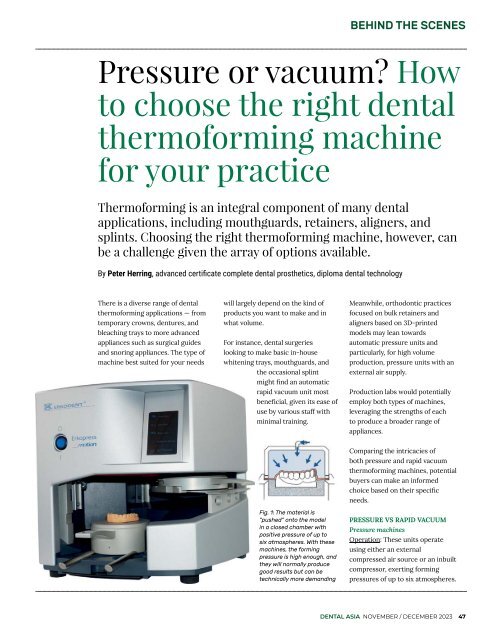Dental Asia November/December 2023
For more than two decades, Dental Asia is the premium journal in linking dental innovators and manufacturers to its rightful audience. We devote ourselves in showcasing the latest dental technology and share evidence-based clinical philosophies to serve as an educational platform to dental professionals. Our combined portfolio of print and digital media also allows us to reach a wider market and secure our position as the leading dental media in the Asia Pacific region while facilitating global interactions among our readers.
For more than two decades, Dental Asia is the premium journal in linking dental innovators and manufacturers to its rightful audience. We devote ourselves in showcasing the latest dental technology and share evidence-based clinical philosophies to serve as an educational platform to dental professionals. Our combined portfolio of print and digital media also allows us to reach a wider market and secure our position as the leading dental media in the Asia Pacific region while facilitating global interactions among our readers.
You also want an ePaper? Increase the reach of your titles
YUMPU automatically turns print PDFs into web optimized ePapers that Google loves.
BEHIND THE SCENES<br />
Pressure or vacuum? How<br />
to choose the right dental<br />
thermoforming machine<br />
for your practice<br />
Thermoforming is an integral component of many dental<br />
applications, including mouthguards, retainers, aligners, and<br />
splints. Choosing the right thermoforming machine, however, can<br />
be a challenge given the array of options available.<br />
By Peter Herring, advanced certificate complete dental prosthetics, diploma dental technology<br />
There is a diverse range of dental<br />
thermoforming applications — from<br />
temporary crowns, dentures, and<br />
bleaching trays to more advanced<br />
appliances such as surgical guides<br />
and snoring appliances. The type of<br />
machine best suited for your needs<br />
will largely depend on the kind of<br />
products you want to make and in<br />
what volume.<br />
For instance, dental surgeries<br />
looking to make basic in-house<br />
whitening trays, mouthguards, and<br />
the occasional splint<br />
might find an automatic<br />
rapid vacuum unit most<br />
beneficial, given its ease of<br />
use by various staff with<br />
minimal training.<br />
Meanwhile, orthodontic practices<br />
focused on bulk retainers and<br />
aligners based on 3D-printed<br />
models may lean towards<br />
automatic pressure units and<br />
particularly, for high volume<br />
production, pressure units with an<br />
external air supply.<br />
Production labs would potentially<br />
employ both types of machines,<br />
leveraging the strengths of each<br />
to produce a broader range of<br />
appliances.<br />
Fig. 1: The material is<br />
“pushed” onto the model<br />
in a closed chamber with<br />
positive pressure of up to<br />
six atmospheres. With these<br />
machines, the forming<br />
pressure is high enough, and<br />
they will normally produce<br />
good results but can be<br />
technically more demanding<br />
Comparing the intricacies of<br />
both pressure and rapid vacuum<br />
thermoforming machines, potential<br />
buyers can make an informed<br />
choice based on their specific<br />
needs.<br />
PRESSURE VS RAPID VACUUM<br />
Pressure machines<br />
Operation: These units operate<br />
using either an external<br />
compressed air source or an inbuilt<br />
compressor, exerting forming<br />
pressures of up to six atmospheres.<br />
DENTAL ASIA NOVEMBER / DECEMBER <strong>2023</strong> 47


















